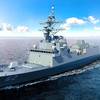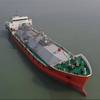U.S. Navy and Coast Guard training teams began their portion of the pilot Global Fleet Station (GFS) on May 1, aboard High Speed Vessel Swift (HSV 2), while in port here.
Global Fleet Station is designed to validate the GFS concept for the Navy and support U.S. Southern Command objectives for its area of responsibility by enhancing cooperative partnerships with regional maritime services and improving operational readiness for the participating partner nations.
Training teams from Navy Expeditionary Combat Command and Expeditionary Training Command in Little Creek, Va., along with U.S. Coast Guard training teams from International Training Division, based in Yorktown, Va., are facilitating three training sessions requested by the nation of Panama.
“The Coast Guard and Navy team have melded into a cohesive unit,” said CWO3 Tom Peal, training team leader. “They’re an outstanding training team, the most professional group of trainers I’ve ever worked with. We’re a total professional force dedicated to the GFS mission.”
The U.S. Navy and U.S. Coast Guard are working together in training on port security and port vulnerability, a U.S. Coast Guard International Training Division course designed for commercial ports.
According to course facilitator, Chief Master-at-Arms(AW) Robert Hewitt, the course is all about showing techniques for assessing internal security and vulnerabilities and to put plans in place to improve those practices."
According to Hewitt, next year the Panamanian maritime and air services are transitioning into a coast guard --providing the services that Task Group 40.9 is facilitating.
“There’s a lot of interaction and interest; it’s definitely a unique experience, and everyone’s been asking the right questions, so that helps,” Hewitt said.
The other training topics are a coxswain course, which focuses on basic navigation and small-boat handling. This course is designed to build the foundation, so the next time GFS visits Colon, later in the deployment, the teams can get into the advanced tactics with the same people.
The leadership seminar, similar to the indoctrination given to new U.S. Navy petty officers, is designed to share ideas on effective leadership.
The Panamanian Sailors attending the leadership seminar are very professional, experienced and well trained, said Senior Chief Master-at-Arms (SW/AW) Marc Owins, leadership facilitator.
“I find them, in every respect, equal to the Sailors I’ve spent a career with in our own Navy," Owins said. "Their comprehension and added input to serious discussions on leadership have had total participation from the most junior to the most senior member. I have no doubt the future of the Panamanian security forces is bright.”
Task Group 40.9 and HSV-2 Swift, are deployed to the Caribbean basin in Central America as part of the pilot Global Fleet Station. Embarked on board Swift are elements of the Navy Expeditionary Training Command, U.S. Coast Guard International Training Division and Department of State representatives.
Global Fleet Station and HSV-2 Swift are scheduled to bring their teams to Belize, Dominican Republic, Guatemala, Honduras, Jamaica, Nicaragua and Panama.
By Story by Mass Communications Specialist 1st Class(SW) Cynthia Clark, CTG 40.9 Public Affairs
Subscribe for
Maritime Reporter E-News
Maritime Reporter E-News is the maritime industry's largest circulation and most authoritative ENews Service, delivered to your Email five times per week










